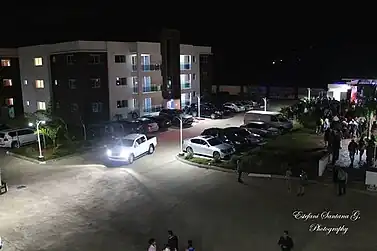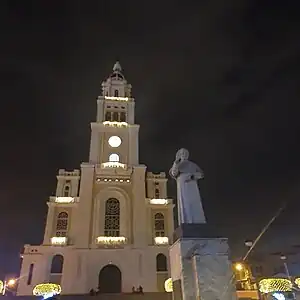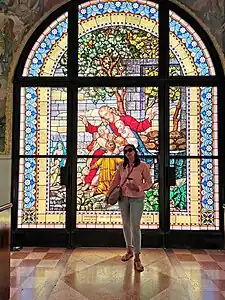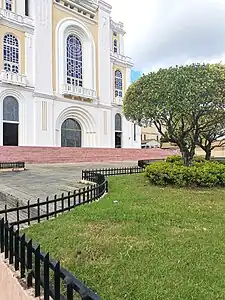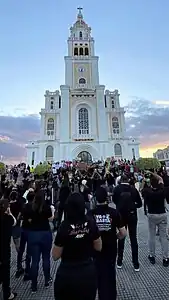Moca, Dominican Republic
Moca is the capital of Espaillat province in the Cibao region of the Dominican Republic, and is the tenth-largest city of the country with a population of 173,442 inhabitants.[4] Moca is located 11 miles/18 kilometers east from the country’s second-largest city, Santiago. It is divided into eight municipal districts: San Víctor, Las Lagunas, José Contreras, Juan López, El Higuerito, La Ortega, Monte de la Jagua and Canca La Reina.
Moca | |
|---|---|
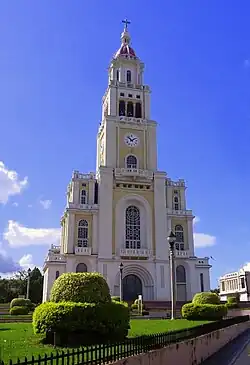 Iglesia del Sagrado Corazón de Jesús in Moca, Dominican Republic | |
 Seal | |
 Moca | |
| Coordinates: 19°23′N 70°31′W | |
| Country | |
| Province | Espaillat |
| Municipality since | 1822 |
| Area | |
| • Total | 239.36 km2 (92.42 sq mi) |
| Elevation | 183 m (600 ft) |
| Population (2012)[3] | |
| • Total | 173,442 |
| • Density | 720/km2 (1,900/sq mi) |
| • Demonym | Mocano(a) |
| Distance to – Santo Domingo | 145 km |
| Municipalities | 8 |
| Climate | Af |
| Website | http://am.gob.do/ |
The city is known as "La Villa Heroica" (Village of Heroes) due to the number of men and women from Moca who have played a major role in the Dominican Republic's history in bringing down two dictators, Ulises Heureaux and Rafael Trujillo, and bringing democracy back to the country.
Moca is home to the Corazon Sagrado de Jesus ("Sacred Heart of Jesus") Cathedral. All its pane glass windows were originally brought from Italy depicting the apostles and Jesus' path to the crucifixion. Agriculture forms the primary livelihood of the inhabitants. Plantain and yucca are main crops. Most crops are harvested by hand.
History
At the time of its colonization by the Spanish, what is now Moca was part of the chiefdom of Maguá. Moca was founded in 1780.[5] In 1845, Moca is designated common of the department of La Vega, then in its political division it becomes the head municipality of the Espaillat province.
Economy

Moca has a very important banking sector, the city is home to branches of all commercial banks of the country. A strong business in shops, furniture, supermarkets, warehouses, factories of footwear, food, construction, and hardware.
The city has the largest coffee manufacturing industry, Industries Banilejas.[6] The city is also known for its agricultural production, with the plantain, banana and cassava as major crops. Other fruits: bananas, pigeon pea, taro, yams, squash, beans, coffee, oranges, lemons, grapefruit, papaya (papaya), etc. A variety of vegetables such as lettuce, tomatoes, eggplants, peppers, cabbage are cultivated, among others. It also has a great development in poultry products, with a production of 70% in this sector.
Church of Moca
Geography
Moca has a total area of 339.21 km².[1] The municipality sits on a volcanic coral reef with hills to the west and low mountains to the north; these mountains are part of the Cordillera Septentrional. The highest mountain in the municipality, and in the province, is El Mogote at (970 m). Moca is at an elevation of 183 m with an average temperature in the city of 26,5 °C in 2022 and an average rainfall of 192,55 mm in 2022.
Climate
| Climate data for Moca, Dominican Republic (2022) | |||||||||||||
|---|---|---|---|---|---|---|---|---|---|---|---|---|---|
| Month | Jan | Feb | Mar | Apr | May | Jun | Jul | Aug | Sep | Oct | Nov | Dec | Year |
| Record high °C (°F) | 33.4 (92.1) |
32.7 (90.9) |
33.4 (92.1) |
34.9 (94.8) |
36.2 (97.2) |
36.1 (97.0) |
35.8 (96.4) |
35.8 (96.4) |
37.4 (99.3) |
35.7 (96.3) |
33.8 (92.8) |
32.5 (90.5) |
37.4 (99.3) |
| Average high °C (°F) | 31.8 (89.2) |
30.5 (86.9) |
31.0 (87.8) |
31.5 (88.7) |
33.9 (93.0) |
34.2 (93.6) |
33.6 (92.5) |
33.0 (91.4) |
34.7 (94.5) |
34.0 (93.2) |
32.4 (90.3) |
30.6 (87.1) |
32.6 (90.7) |
| Average low °C (°F) | 17.9 (64.2) |
18.4 (65.1) |
19.0 (66.2) |
19.6 (67.3) |
21.0 (69.8) |
22.3 (72.1) |
22.5 (72.5) |
23.3 (73.9) |
22.6 (72.7) |
21.5 (70.7) |
19.6 (67.3) |
17.5 (63.5) |
20.4 (68.7) |
| Record low °C (°F) | 14.3 (57.7) |
14.2 (57.6) |
17.4 (63.3) |
17.4 (63.3) |
18.5 (65.3) |
20.1 (68.2) |
20.2 (68.4) |
20.5 (68.9) |
20.9 (69.6) |
20.3 (68.5) |
16.8 (62.2) |
14.3 (57.7) |
14.2 (57.6) |
| Average rainfall mm (inches) | 13.3 (0.52) |
51.3 (2.02) |
58.9 (2.32) |
48.4 (1.91) |
65.5 (2.58) |
1.9 (0.07) |
27.8 (1.09) |
11.5 (0.45) |
71.7 (2.82) |
12.9 (0.51) |
7.3 (0.29) |
14.6 (0.57) |
385.1 (15.15) |
| Average rainy days | 4.8 | 13.5 | 10.0 | 7.8 | 4.1 | 1.2 | 8.0 | 6.2 | 5.9 | 3.4 | 13.6 | 4.3 | 82.8 |
| Source: NOAA[7] | |||||||||||||
Notable residents
- Trina de Moya (1863–1943) – poet and First Lady of the Dominican Republic (1899, 1902–1903, 1924–1930)[8]
Sports
- Estadio Bragaña Garcia, baseball stadium
References
- Superficies a nivel de municipios, Oficina Nacional de Estadistica Archived 2009-04-17 at the Wayback Machine
- De la Fuente, Santiago (1976). Geografía Dominicana (in Spanish). Santo Domingo, Dominican Republic: Editora Colegial Quisqueyana.
- Censo 2012 de Población y Vivienda, Oficina Nacional de Estadistica
- Expansión Urbana de las ciudades capitales de RD: 1988-2010 (in Spanish). Santo Domingo: Oficina Nacional de Estadística. 1 May 2015. ISBN 978-9945-8984-3-9. Archived from the original on 14 July 2016. Retrieved 25 January 2016.
- "Moca | Dominican Republic | Britannica".
- "Municipio de Moca". Retrieved 6 September 2016.
- "Moca Climate Normals 1961-1990". Accuweather. Retrieved September 18, 2016.
- Mercado, Sergia (2021-03-05). "Dominicanas Ilustres: doña Trina de Moya de Vásquez, María Montez y Mamá Tingó". El Caribe (Dominican Republic). Archived from the original on 2021-08-13. Retrieved 2021-08-18.

